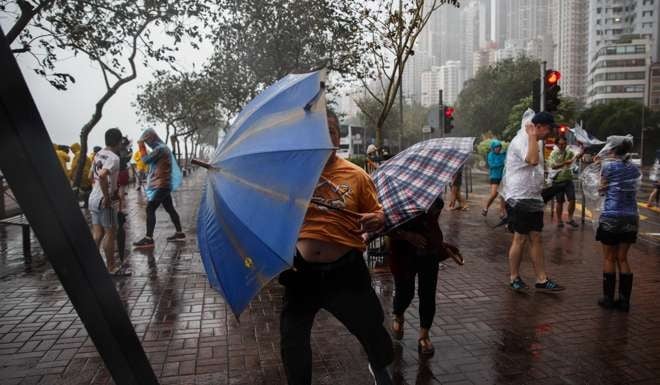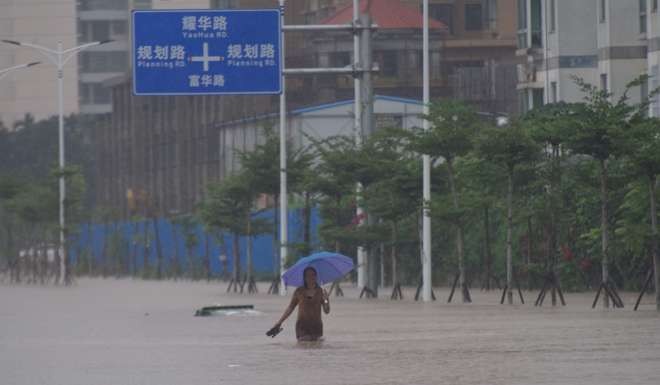
Typhoons and storms that shook Hong Kong in 2016
Typhoons hitting Hong Kong exceeded the expectations of weather officials last year and caused 11 days of cumulative typhoon warning signals.
The year ended with a warning that coming seasons would be more “unstable”, with big fluctuations in temperatures.
Nine tropical storms came within 800km of Hong Kong’s centre this year, although not all of them hit with the same intensity.
City University chair professor of atmospheric science Johnny Chan Chung-leung believed there could be more frequent extreme weather events and big fluctuations in temperatures as climatic changes made the atmosphere more unstable.
Experts believed warmer waters over the Pacific would provide more energy to typhoons and intensify their strength, though they would not necessarily occur more frequently.
A study published in the journal Nature Geoscience this year found that East Asia was buffeted by up to four times as many of the strongest storms a year compared to three decades ago.
Earlier in the year, Hong Kong Observatory director Shun Chi-ming had predicted the number of typhoons coming within 500km of the city this year would be a normal four to seven, similar to last year, although more would come late season.
2016 in storms

Typhoon season for Hong Kong began on May 26 with a tropical depression forming off the east coast of Hainan Island, prompting the issuing of a No 1 standby signal. It was later upgraded to No 3 as it entered the territory’s 400km perimeter. Maximum wind speeds reached about 45km/h, and the storm fizzled out as it made landfall over southwest Guangdong the next day.
The city would not see another storm signal issued until late July. On the 25th, tropical storm Mirinae barrelled toward the Gulf of Tonkin in the South China Sea from west Luzon, the Philippines, intensifying into a severe tropical storm. It swooped over Hainan before bashing into northern Vietnam. While the impact on the city was minimal, the No 1 signal was up for nearly 15 hours. Maximum wind speeds recorded at the Observatory reached 85km/h.
Nida stops Hong Kong, but Pokemon hunt continues
Mirinae may have been a non-event for most Hongkongers but a week later, the city would be hit by its first major typhoon of the year – Typhoon Nida. Packing gale force winds, Nida lashed Hong Kong for a total of 43 hours. A No 8 signal was issued August 1 and would remain in place for 16 hours. At its closest point, Nida’s eye was just 20km from Hong Kong. In its aftermath, about 400 trees collapsed and 300 hectares of farmland were affected. At least 12 people were hospitalised. All storm signals were cancelled by August 3.
Tropical Storm Dianmu
Later that month, on August 17, Hong Kong had a close encounter with tropical storm Dianmu. Its approach battered the city with strong winds and rain but the signal never went past No 3. It was downgraded back to a No 1 signal the next morning before being cancelled two hours later as Dianmu moved west toward Beibu Wan.
Watch: Super typhoon Meranti slams Taiwan
On September 8, the Joint Typhoon Warning Centre issued an alert over a tropical cyclone formation about 155km west of Guam. This one was expected to be big, a category five “super typhoon” named Meranti, after a type of tree in Malaysia. Meranti gave southern Taiwan a thrashing before it slamming into Fujian on the mainland, shattering buildings and flooding streets. But Hong Kong, again, was left unscathed as it scraped the 400km radius. A No 1 signal was cancelled after 18 hours.
Typhoon Megi
A typhoon of similar strength and trajectory, Megi, would enter the region at the end of September, keeping a No 1 signal in place for 14.5 hours. This was followed by severe tropical storm Aere in early October, which kept a No 1 signal in place for two days, dissipating as it moved inland over Vietnam.
Typhoon Sarika

Sarika formed as a tropical depression over the east of Manila on October 13, intensifying into a severe typhoon as it entered the South China Sea. A standby signal No 1 was issued on October 16 and was upgraded to a No 3 signal the following afternoon. Sarika’s passage brought heavy wind and rain to the city, and there were at least 14 reports of flooding and seven reports of landslides. All signals were cancelled after 48 hours.
Super typhoon Haima
Just days later came super typhoon Haima, the last big storm to affect Hong Kong in 2016 and the first to cause a No 8 signal in October in more than two decades. The late-season beast hammered the city with gale force winds, shutting down schools, businesses, courts, stock markets and offices. At least one person was left dead in its wake. Up to 740 flights were cancelled or delayed, and the government received nearly 200 reports of fallen trees. Haima weakened as it moved inland, and with winds subsiding, all storm warning signals were cancelled after 37 hours.

